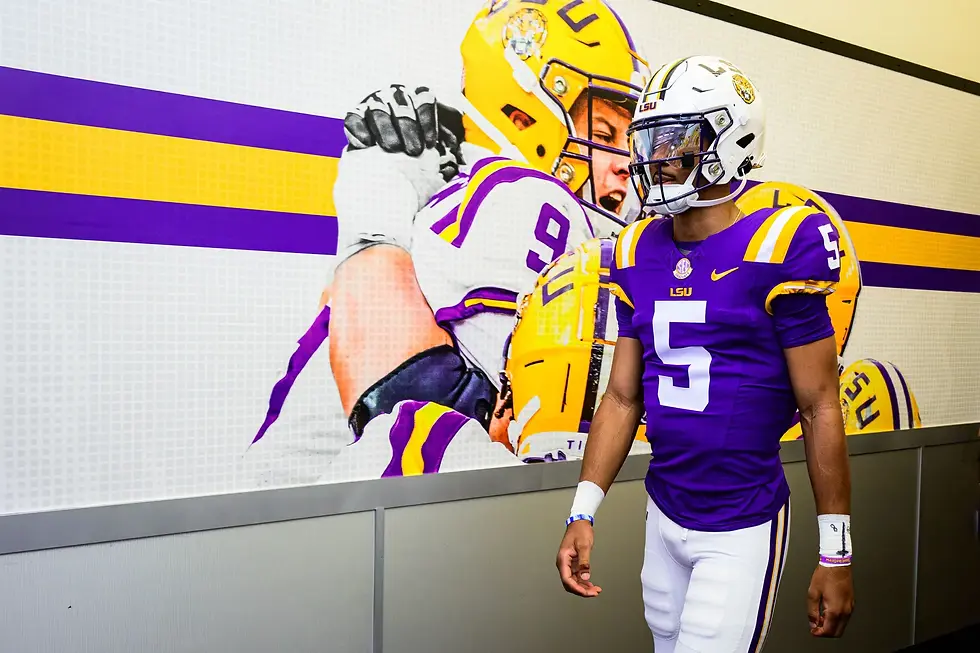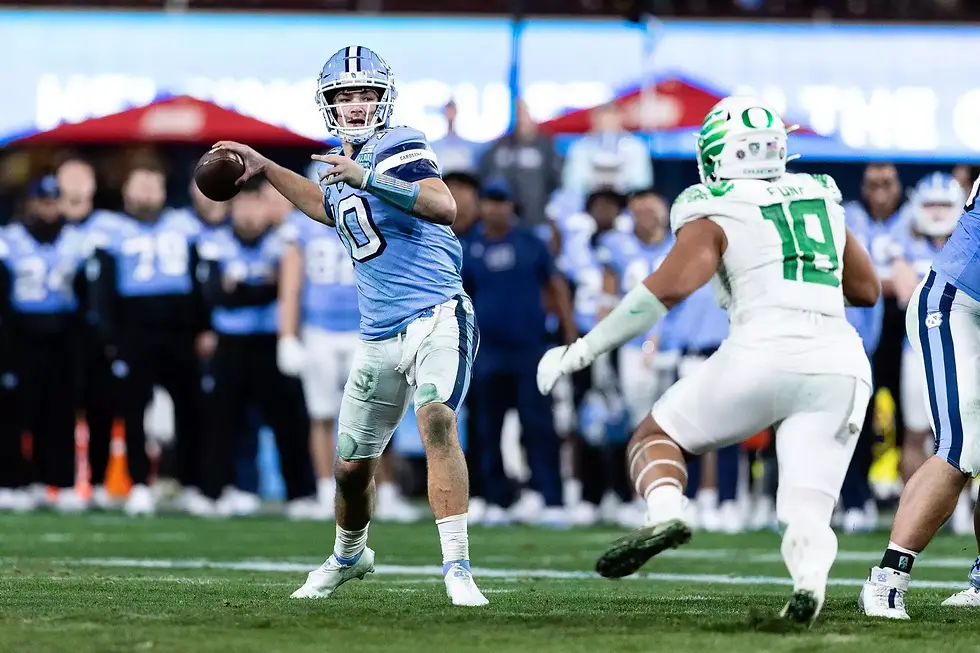Patriots: QB J.J. McCarthy Scouting Report
- Tanner James

- Feb 27, 2024
- 6 min read
The New England Patriots are faced with a unique situation: draft a QB third overall or trade down. As rumors swirl about other teams being interested in trading up, the Patriots are naturally thrust into those conversations as they have a multitude of holes on their roster that extend beyond QB. If that were to happen, and the Patriots traded down, it is important to be aware of other QB options and how they stack up against each other. I am making scouting reports for all of the top ten QB prospects in the NFL draft with full positional rankings to come after the combine. Here is the third part of my series covering the top ten QBs in the upcoming NFL draft.
QB J.J. McCarthy(#9)
Date of Birth: January 23rd, 2003.
Age at draft: 21

Strengths:
He played in a pro-style offense that utilizes a mixture of under-center and shotgun plays, with heavy experience in play-action from both shotgun and under-center.
His arm talent is legit, can throw from multiple arm angles, and generates elite velocity, especially to the short and intermediate parts of the field. There will be no concerns regarding his ability to push the ball outside the numbers.
Routinely shows the ability to fit the ball into a keyhole. His tape is littered with tight-window throws.
Has a fast, short-armed release that is coveted amongst QBs.
He is an incredibly young prospect at just 21 years old on draft night.
Despite the low volume, he showed the ability to get through his progressions comfortably. He remained composed and didn't resemble a deer caught in headlights, nor did he freeze when his initial read wasn't available.
He is a tough runner, willing to engage in contact to get the first down/touchdown.
He is an impressive off-platform thrower, something that is becoming a requirement to be a top-tier QB in the NFL. McCarthy is amongst the best off-platform throwers in the class. Even when his cleats aren't firmly planted, his throwing velocity doesn't tank, and his accuracy remains consistent.
He's adept at throwing from various awkward angles and possesses enough short-area quickness to maneuver outside the pocket horizontally and create opportunities for plays.
Michigan was a powerhouse through their run game and defense, but their pass catchers were average. McCarthy’s best-receiving option, Roman Wilson, was used poorly and his skill set was not maximized. I wouldn’t be shocked if Wilson turns out to be more productive in the NFL than in college.
He is an aggressive thrower, willing to test windows that other QBs would shy away from. He is fully aware of his ability to drive the ball into tight windows. That is a coveted trait.
Signs of being an anticipatory passer. As Bruce Arian's famously said, you want a passer, not a thrower. "Throwers wait to see a receiver break open and then sling it in that direction, usually as hard as they can. Passers release the ball before the receivers get open, usually with the right velocity and touch, Arians said." McCarthy created passing opportunities with timing. More often than not, the ball was out before the receiver entered their break and "on them" as they exited their break.
Impressive pocket maneuverability. He has a natural feel for pressure, side-stepping pass rushers, and climbing the pocket.
Incredible situational awareness. McCarthy was always aware of the down and distance and did a great job of getting the ball to the sticks on third down. He would pass over the “easy option”, something that was often open underneath like a drag route, and extend the play to find a way to get the first down. Easily one of his most appreciable traits.
Weaknesses:
The most glaring and discussed concern is just the sheer lack of volume with which he threw the ball. He wasn’t asked to drop back and throw the ball 60 times in any game. When they called on him, he was impressive more often than not but there is just a lack of tape of him dissecting top-tier defenses.
Although timing was a plus trait, I do think there is more untapped potential in that regard. He can be a bit slow to trigger on open pass catchers, which required him to make some more tight window passes than I thought was necessary.
The run game was so dominant for Michigan that it created favorable passing circumstances, especially off of play-action. More often than not his first read would be open.
Hard to say without seeing the testing numbers, especially for McCarthy, but he appears closer to an average athlete than an upper-echelon one. I do think some of the scrambling will be more limited in the NFL against faster defensive linemen/linebackers.
Can be a bit of a “one-speed thrower” at times, doesn't show as much touch as you would like. He did improve on that from his sophomore to junior season though.
In an offense that didn’t go vertical often, McCarthy's deep ball accuracy needs work. The ball placement on passes downfield was shaky. Admittedly, it could be a combination of factors as Michigan rarely took deep shots, but I do think taking some heat off his passes or learning how to control his ball speed could improve his deep ball placement.
There were some examples of what I would call “low-calorie yards” on tape. Michigan would often send four vertical routes downfield while having a running back run a delay route, swing route, or flat route. McCarthy would then dump the ball off to the running back, who would capitalize on the ample space created by defenders covering the deep routes, resulting in significant yards after the catch. This isn’t necessarily a knock on McCarthy, as he is doing the right thing by getting the ball to his playmaker as designed, but I thought it was noteworthy as it added a bit more inflation to the box score stats.
Occasionally, he would opt for the 'easy throw' on early downs rather than allowing plays to fully develop and maximize potential. While his willingness to take check-downs is generally a positive sign, the lack of volume makes it challenging to determine if he played too conservatively on early downs at times.
Bottom Line:
JJ McCarthy is a polarizing prospect; nearly everyone you talk to has a different opinion of him. I do think it is fair to say there might be too much hype regarding him being a top-10 prospect in the 2024 NFL draft. The best path for McCarthy is if he lands with a team that has an entrenched starter whom he can sit behind for a year or two as he continues to develop—a path similar to Jordan Love's.
On the opposite end, there is a subset of people who believe there are no qualities to his game, but that group is not watching what was put on tape. McCarthy flashes plus starter traits and has the physical tools coveted in QB prospects. He demonstrates adequate accuracy in the short to intermediate parts of the field and is an aggressive thrower who excels at capitalizing on tight-window throws. McCarthy exhibits impressive situational awareness, which played a significant role in Michigan’s success, despite some people’s reluctance to admit it. He was extremely effective when called upon by Michigan, particularly on third down. Moreover, he has shown the ability, albeit in a smaller sample size, to be a net positive passer under pressure—another highly coveted trait.
At just 21 years old on draft night, McCarthy is an extremely young prospect. He made significant strides as a passer from his sophomore to junior season, showing positive signs of development. I believe it is crucial for his continued growth that he spends at least one season sitting behind someone. He still has areas to improve upon, such as controlling the RPMs on his passes, deep accuracy, and acclimating to the demands of being a 40+ attempt passer.
The bottom line is that McCarthy possesses numerous coveted traits shared among the top quarterbacks in the league. However, he remains raw as a passer and lacks the necessary experience to step in as a day-one starter in the NFL. Green Bay Packers quarterback Jordan Love's trajectory mirrors this scenario. Love, coming off his inaugural season as the Packers starting QB, showcased the benefits of sitting behind a starter. He had the advantage of learning from a Hall of Fame quarterback for several seasons, which seemingly translated to his development. Similarly, Patrick Mahomes benefited from a year of learning behind Alex Smith and being coached by Andy Reid. If McCarthy can land in a situation where he isn't expected to carry a franchise immediately, it wouldn't be surprising to see him develop into a plus starter in a few years.
Twitter Links:
You can see some of the clips of the film I have shared with finer details to get a clearer picture of a prospect.
Pocket Movement/Under Pressure:
Clip one:
Clip two:
Clip three:
Clip four:
Clip five:
Short and intermediate accuracy:
Clip one:
Third down proficiency:
Clip one:
Arm Talent/Tight Window Throws:
Clip one:
Clip two:
Clip three:
Clip four:
Clip five:
Clip six:
Explanation/deep dive into the lack of reps:
Clip one:
Taking the easy play on early downs:
Clip one:
Clip two:
Deep accuracy issues:
Photo courtesy of Michigan Athletics.






Comments